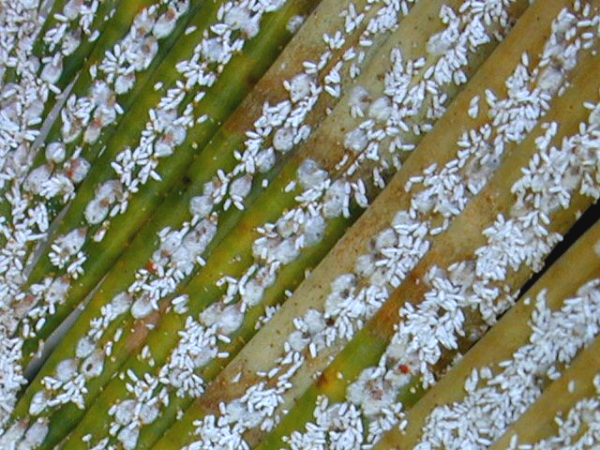Native to Thailand and here to stay the cycad aulacaspis scale is ravaging sago palms (Cycas revoluta) throughout Florida.
 Native to Thailand and here to stay, the cycad aulacaspis scale is ravaging sago palms (Cycas revoluta) throughout Florida. These scales were first found in Miami in 1996. Since then, they have moved upstate, leaving a trail of dead or decaying sago palms behind them. The aulacaspis scale infests the roots of the sago palm and then moves up the trunk to suckplant juices from the underside of the fronds. Yellow spots form on the fronds initially followed by entire frond death.
Native to Thailand and here to stay, the cycad aulacaspis scale is ravaging sago palms (Cycas revoluta) throughout Florida. These scales were first found in Miami in 1996. Since then, they have moved upstate, leaving a trail of dead or decaying sago palms behind them. The aulacaspis scale infests the roots of the sago palm and then moves up the trunk to suckplant juices from the underside of the fronds. Yellow spots form on the fronds initially followed by entire frond death.
Due to the ability of the scale to infest both roots and foliage, eradication is nearly impossible and treatments are temporary at best. However, horticulture oils can provide temporary relief and prolong the life of the Sago Palms. Multiple follow-up treatments are necessary. Scales can be persistent and may not fall off immediately after dying but you can use a garden hose after awhile to wash off dead scales. Anymore, the sago palm is not recommended for Florida landscapes because of this persistent, invasive pest.
As an alternative to constant treatments, we recommend replacing sago palms with a different plant that is not affected by the scale. European Fan Palm ( Chamaerops humilis) is one of the more popular plants people choose because of its small size and similar texture. Other plants very close in appearance to the sago palm are the Dioon cycad ( Dioon edule) and the Cardboard Plant ( Cycas furfuracea).


